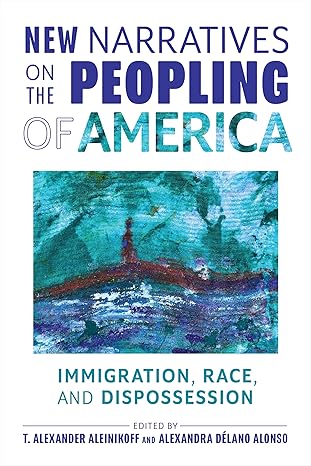The Book
New Narratives on the Peopling of America: Immigration, Race, and Dispossession
The Author(s)
T. Alexander Aleinikoff and Alexandra Délano Alonso

New Narratives on the Peopling of America: Immigration, Race and Dispossession is a collection of essays that challenge the existing narratives about immigration, displacement, and forced movement. The collection aims to challenge the seemingly fixed perceptions of immigration – both its history and the contemporary political discourse surrounding it – by privileging discussions of race, the myth of whiteness, and the role of land dispossession within narratives about the populating of the Americas. Broken into three sections: “Making a Narrative”, “Beyond a ‘Nation of Immigrants’”, and “Alternative Narratives”, the collection spans a broad historical range offering thematic unity across sections. Each section is comprised of a variety of pieces – historical and critical essays, photography, poetry, and pieces that bring the personal into direct contact with the sociopolitical. This approach makes clear that peopling of the Americas is a multifaceted issue that requires many different voices, lenses, and paradigms.
In the first section, “Making a Narrative”, co-editor and author Alexandra Délano Alonso raises the importance of “larger stories” that “look beyond the United States of America. Larger stories that understand migration as a continuum of international displacement, emigration, transit, immigration, and return. Larger stories that connect the struggles of migration within structures of capitalism and white supremacy, and in relation to broader struggles of mobility, solidarity, and justice”.[1] The idea of “larger stories” provides an ethos for the entire collection – as Délano Alonso suggests, it’s not enough to add more narratives to our existing understandings of immigration and displacement, it’s about expanding what we already know and how those narratives are conceptualized, articulated, and circulated. In the book’s second section, “Beyond a ‘Nation of Immigrants’”, the essays challenge the formation of the United States as a “nation of immigrants” as an unquestioned and celebratory construction of the nation-state. The following essays examine different dimensions of immigration – labor, economics, history, sexuality, and religion – to demonstrate how simplistic narratives undercut the inherent challenges (and violences) that accompany the peopling of any landmass. These essays widen the scope of what constitutes immigration in the United States and how immigration has (re)shaped various understandings the Americas. The book’s third section, “Alternative Narratives”, proposes just that: narratives that challenge dominant understandings of the peopling of the Americas while drawing attention to what is missing, overlooked, or silenced. The essays and art pieces in this section highlight the ways that narratives take shape, how they circulate, and why their persistence matters.
The book’s final essay, “Elements of a National Narrative on the Peopling of America” by co-editor T. Alexander Alienkoff, further emphasizes the significance of narrative. As he writes, “narratives are not fixed, they are open to new and revised tellings”.[2] Understanding narratives as unfixed allows for “larger stories” that acknowledge the complex histories – personal and collective – of dispossession underlying the peopling of the Americas. As many of the authors and artists in the collection have suggested, reimaging these narratives requires looking at the intersections of settler-colonialism, immigration, race, whiteness, and dispossession. The United States and the Americas, more broadly, contain many narratives and there are many ways to tell that story.
However, because of the variety of formats, the essays do fall into a few repetitions at certain points – repeated histories and central claims – but by and large each essay helps to make clear the importance of the collection overall. The essays are engaging and readable; many of them would make sense in a variety of classrooms about immigration, race, American history, Indigenous history, and even border studies.
Overall, there might not be anything particularly “new” about this collection, but it certainly offers a renewed sense of urgency around the ways we discuss and understand immigration. As many of the essays assert, we cannot properly discuss immigration in the United States absent of race. Rather, race and the myth of whiteness are central to the construction of the United States, particularly as whiteness expands to assimilate certain immigrants over time and exclude others. Instead, the collection offers new ways of seeing, looking, and intersections that reinvigorate our understanding of what immigration means – politically, socially, economically, and nationally. As the authors and artists in the collection demonstrate, the narratives we craft about immigration elide, illuminate, and complicate our national understandings of race and dispossession. It is our responsibility to continuously return to these complex histories to unpack our contemporary narratives about immigration, particularly as immigrants are repeatedly targeted by U.S. policy. Above all, the collection is, unfortunately, very timely with the changing presidential administration and renewed focus on immigration raids and border enforcement. The essays make clear the force of our narratives about immigration and provide an understanding of how we got here.
[1] Alexandra Délano Alonso, “Toward Larger Stories: New Narratives on the Peopling of the United States of America,” in New Narratives on the Peopling of America: Immigration, Race, and Dispossession, ed. T. Alexander Aleinikoff and Alexandra Délano Alonso (Baltimore: Johns Hopkins University Press, 2024), 10.
[2] T. Alexander Aleinikoff, “Elements of a National Narrative on the Peopling of America”, in New Narratives on the Peopling of America: Immigration, Race, and Dispossession, ed. T. Alexander Aleinikoff and Alexandra Délano Alonso (Baltimore: Johns Hopkins University Press, 2024), 433.
About the Reviewer
Alyssa Quintanilla is an Assistant Professor of English at the United States Naval Academy where she specializes in Latinx Literature and Culture, Border Studies, Environmental Literature, Multi-Ethnic Literature, and the Digital Humanities. She is author of “Border Trash: Recovering the Waste of U.S.-Mexico Border Policy in ‘Fatal Migrations’ and 2666”, Lateral: Journal of the Cultural Studies Association, “Mourning as Resistance: Seeing and Hearing the Borderlands through Vistas de la Frontera”, The Digital Review, Issue 01, Fall 2021, and “Mourning Absence: Place, Augmented Reality (AR), and Materiality in The Border Memorial”, Journal of Media Art Study and Theory.

0